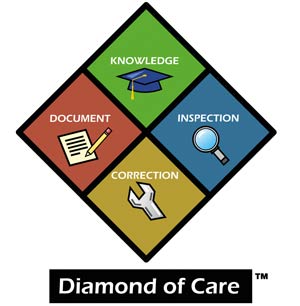 Diamonds Are a Park’s Best Friend Diamonds Are a Park’s Best Friend Ineffective playground maintenance and inspections reportedly contribute to nearly 40 percent of all playground injuries. PDRMA’s Playground Maintenance Diamond of CareTM is a four-point program that addresses proper maintenance via Knowledge, Inspection, Correction and Document. But these principles aren’t limited to just playgrounds. You can use the Diamond of Care for all your park and facility operations — and reap the benefits.
“Diamond of Care focuses on the complete maintenance cycle,” says Jackie Pierce, PDRMA Risk Management Consultant, “which is applicable to nearly every department at an agency.”
Here’s how you can incorporate the Diamond of Care throughout your agency.
Recreation — Fitness Equipment
 Study the owner’s manual to determine the preventive maintenance plan for each piece of equipment. “This is how you gain knowledge about the equipment and how it works, so you can identify when it’s not working properly,” Pierce explains. Study the owner’s manual to determine the preventive maintenance plan for each piece of equipment. “This is how you gain knowledge about the equipment and how it works, so you can identify when it’s not working properly,” Pierce explains. - Create an inspection program (and form) based on manufacturer recommendations and general knowledge of that type of equipment. Frequent inspections identify general operational concerns, wear and tear, and damage. “If something isn’t working correctly or is broken, use lock-out/tag-out to take it out of operation,” she advises.
- Develop a plan to correct the issue. Document this plan and continue inspections to ensure no one uses the machine and lock-out/tag-out is in place.
- Document when you fix the piece, and it’s back in operation.
Aquatics — Water slide
 Study the owner’s manual to determine the preventive maintenance plan for the slide. Know how the slide operates — flow rate, surface, water outlets — to identify issues more easily. Study the owner’s manual to determine the preventive maintenance plan for the slide. Know how the slide operates — flow rate, surface, water outlets — to identify issues more easily. - Create an inspection program (and form) based on manufacturer recommendations and general knowledge of the slide. Frequent inspections will identify operational concerns, wear and tear, and damage. Use lock-out/tag-out to take the slide out of operation if something isn’t working properly. “You’ll also want to plan a third-party inspection for structural integrity based on the frequency dictated by the slide manufacturer,” Pierce adds.
- Develop a plan to correct the issue. Document it and continue inspections to ensure no one uses the slide, and lock-out/tag-out is still in place.
- Document when you fix the piece, and it’s back in operation.
Golf — Golf Cart
 Study the owner’s manual to determine the preventive maintenance plan for the cart. Know the cart and how it operates — speed, brakes, etc. — so you know if it is not working properly. Study the owner’s manual to determine the preventive maintenance plan for the cart. Know the cart and how it operates — speed, brakes, etc. — so you know if it is not working properly. - Create an inspection program (and form) based on manufacturer recommendations and general knowledge of the cart. Frequent inspections identify general operational concerns, wear and tear, and damage. Use lock-out/tag-out if something is not working properly or is broken.
- Develop a plan to correct the issue, document the plan and continue inspections to ensure no one uses the cart, and lock-out/tag-out is still in place.
- Document when you fix the cart, and it’s back in operation.
Using the Diamond of Care throughout your agency is easy when you’re familiar with how to apply the four points — Knowledge, Inspection, Correction, Document. “Once you develop a maintenance plan based on the manufacturer’s recommendations, it comes down to regular inspections, correcting problems and documenting everything,” Pierce explains. “The Diamond of Care reduces injury risks, prolongs the life of your equipment and helps protect your agency against liability claims.” Diamonds really are a park’s best friend. |

